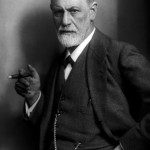
(Wikimedia Commons public domain image)
I read an interesting paper this morning — Stephan A. Schwartz, “Nonlocality and Exceptional Experiences: A Study of Genius, Religious Epiphany, and the Psychic,” Explore 6/4 (July/August 2010): 227-236 — from which I’ll share a few quoted passages. At the time that he published his article, Stephan Schwartz was Senior Samueli Fellow for Brain, Mind, and Healing at the Samueli Institute, in Alexandria, Virginia.
First, the abstract:
Two hundred years of reductive materialism has failed to explain the extraordinary experiences we know as moments of genius, religious epiphany, and psychic insight. This paper proposes that these three experiences are in essence the same experience, differentiated only by intention and context. It reaches this conclusion based on well-conducted experimental research across the continuum of science—work that proposes a new interdependent model of consciousness that takes into consideration a nonlocal linkage or entanglement, as an aspect of consciousness not limited by space and time. The paper surveys some of the most important relevant research from quantum biology, physics, psychology, medicine, anthropology, and parapsychology. It proposes that more attention should be paid to the autobiographies, correspondence, and journals of men and women to whom history unequivocally accords the designation of genius, saint, or psychic, offering examples from these sources. And it presents comparisons between ethnohistorical material and spiritual traditions, suggesting they arrive at a similar worldview. Finally, it proposes that meditation research, some examples of which are cited, be seen in the context of psychophysical self-regulation, and that it offers one powerful avenue for producing these exceptional experiences. (227)
And now the Introduction:
For almost 200 years, the most intellectually rigorous approach we have had for examining the world—science— has had a strong bias toward reductive materialism. From this perspective, spiritual ecstasy is delusional, creative processes are the result of genetics and reinforcements, and parapsychological functioning is impossible. Yet from time immemorial, these experiences have been reported across geography and culture, and continue to be so today. After a century or more of trying to explain them by using the reductive analytical model, the result is acknowledged to be inadequate. There is an aspect of consciousness that has not been accounted for by the materialist worldview. Materialism asks us to believe these quite common experiences cannot be what they so obviously are: an aspect of consciousness not limited by space/time—the nonlocal aspect of consciousness.
In contrast to this materialist perspective, an interdependent model is emerging that sacrifices nothing in scientific rigor while incorporating the nonlocal and providing a framework for experimentation and hypothesis testing. This research appears in hundreds of studies, from many disciplines, addressing the non-local. The peer-reviewed journals that are science’s benchmark carry papers on quantum entanglement amongst insects, animals, and birds, distant mental influence, interactions between species, the efficacy of prayer, and transactions that do not involve standard sense perception. What is notable is that these papers often make few references to research outside of the authors’ own discipline community. I mention this for two reasons: first, it means there is enough research in single disciplines for references to exist, and second, to emphasize the point that these are independently arising lines of inquiry merging into an as yet unacknowledged consensual perspective. This work collectively suggests that religious epiphany, creative breakthroughs, and parapsychological phenomena are, in fact, different manifestations of the same process—allowing the nonlocal aspect of consciousness to emerge into conscious awareness. Sometimes these experiences are spiritual (humanity’s ancient spiritual practices such as meditation attest to this); sometimes they are the insight of creative genius, sometimes merely descriptions of teacups hidden in closets. But regardless of what they are, for the individuals who have them, they are always notable for a sense of connectedness and timeless wholeness.
Functionally and metaphorically in this emerging paradigm, we—all life—can be likened to workstations in a network. Our interactions with this network take place at many planes, from the physical to the nonlocal and, just as in any network from electronic to biological, individuals both inform and influence, even as they are informed and influenced through interaction with this network lying in a domain of nonlocal consciousness.
As Albert Einstein put it:
A human being is a part of the whole, called by us ‘Universe,’ a part limited in time and space. He experiences himself, his thoughts and feelings as something separated from the rest, a kind of optical delusion of his consciousness. This delusion is a kind of prison for us, restricting us to our personal desires and to affection for a few persons nearest to us. Our task must be to free ourselves from this prison by widening our circle of compassion to embrace all living creatures and the whole of nature in its beauty. Nobody is able to achieve this completely, but the striving for such achievement is in itself a part of the liberation and a foundation for inner security. (227-228)
At the opening of his “Discussion,” Schwartz distinguishes two quite different understandings of his subject:
The Physicalist/Materialist Model
Following are some of the hallmarks of materialism:
- The mind is solely the result of physiological processes.
- Each person’s consciousness is a discrete entity.
- No communication is possible except through the defined physiological senses.
- Consciousness dwells entirely within the time/space continuum.
The Interdependent Interconnected Consciousness Model
In place of the physicalist/materialist model, an interdependent perspective is emerging that challenges these assumptions. Some of its principal hallmarks:
- Only certain aspects of the mind are the result of physiological processes.
- Consciousness is causal, and physical reality is its manifestation.
- All consciousnesses, regardless of their physical manifestations, are linked (entangled).
- Some aspects of consciousness are not limited by the space/ time continuum. (228)
Stephan Schwartz is an advocate of the second paradigm, of what he calls the Interdependent Interconnected Consciousness Model.
I have to confess that, for years, I dismissed all parapsychological claims as baseless nonsense, unsupported by the data. That was because I was unfamiliar with the data. I’m now inclined to believe that some such things (e.g., perception at a distance, extraordinary knowing) are demonstrably real, though typically at a very weak “signal strength.” And, if they are real, then “reductive materialism” seems most likely to be false.













